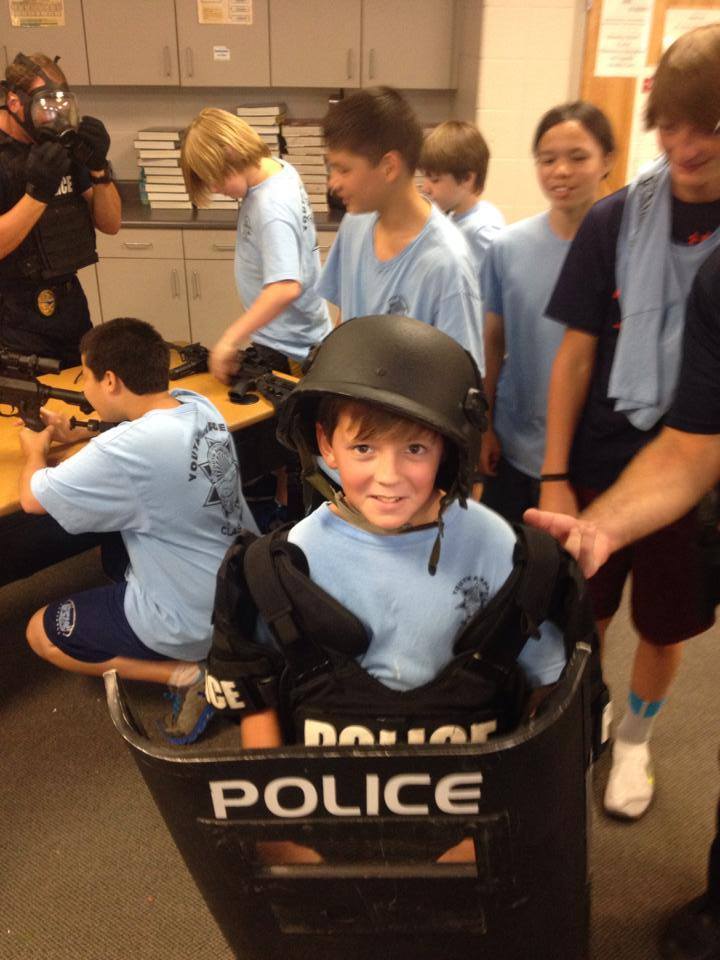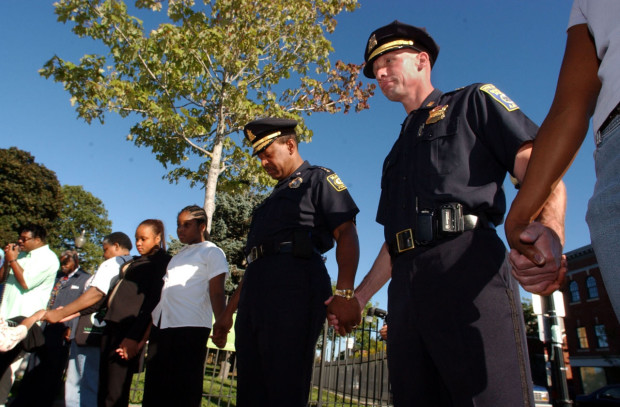Aiming to Redefine Police-Youth Relationships, Nine Projects from Across the U.S. Kick Off New Federal Initiative

Building on a movement to partner across public health and policing, including national discussions and promising projects—like FIT Zones in East Palo Alto, California, and the Homicide Review Commission in Milwaukee—and seeking to improve the lives of minority youth, prevent violence, and establish trust between police and communities, in 2014, the Office of Minority Health partnered with the COPS Office to craft a three-year grant encouraging local jurisdictions to build collaborative approaches involving police and public health agencies. The resulting initiative, “Minority Youth Violence Prevention (MYVP): Integrating Public Health and Community Policing Approaches,” will use promising violence prevention and crime reduction models to address public health and public safety concerns for the community, focusing in particular on at-risk minority male youth, and seeking to establish approaches that can be replicated.
The first summit for the MYVP initiative, sponsored in February by the Office of Minority Health of the U.S. Department of Health and Human Services (HHS) and the U.S. Department of Justice Office of Community Oriented Policing Services (COPS Office), brought together more than 30 grantees at the DeKalb County Police training facility in Lithonia, Georgia. Participants ranged from police officers to hospital leaders to prosecutors to public health and social service experts and represented nine selected projects in Binghamton, New York; Cincinnati, Ohio; Cabarrus County, North Carolina; DeKalb County, Georgia; Hennepin County, Minnesota; Oakland, California; Sacramento, California; Chatham County, Georgia; and West Palm Beach, Florida.
“One of the greatest struggles in this country is public trust in law enforcement,” said Dr. Cedric Alexander, deputy chief operating officer of the Office of Public Safety at the DeKalb County Police Department, in the keynote speech. Dr. Alexander, who serves on President Obama’s Task Force on 21st Century Policing, spoke to the participants about trust and minority youth, citing recent conflicts in Ferguson and Staten Island. “Messaging is so important for young people,” he said. “When you tell them that ‘the world is waiting on you to make a difference,’ they get the sense that they are valued.”
Dr. J. Nadine Gracia, Deputy Assistant Secretary for Minority Health in the HHS, added that recent events in Ferguson, Cleveland, and Staten Island have exposed rifts between communities and law enforcement that urgently need to be addressed by these projects. “Whether you are a local public official or work with a community-based initiative, your leadership and partnership with the Office of Minority Health and the COPS Office through the MYVP program is critical to addressing youth violence, not only as a public safety issue but also as a significant public health issue,” she said.
Despite decreasing national crime trends, many minority communities across the country are still plagued by high rates of violence. In 2011, homicide was the third leading cause of death among all youth (15- to 24-year-olds), the second leading cause of death for Hispanic youth, and the most common cause of death for African-American youth. The violence that persistently kills minority youth deprives families of promising futures, affects the health and safety of entire communities, and continues to be among the nation’s most complex problems.
John Markovic, senior social science analyst at the COPS Office, added that the MYVP initiative is “incredibly unique.” Markovic offered an overview of problem-oriented policing perspectives and ways police can enhance practices with public health techniques, such as mapping the spread of violence like a contagious disease or looking at different kinds of data to predict who is at risk for victimization. “There are abstract definitions of what public health models of violence prevention look like—about interrupting the transmission of violence by changing the thinking of people who transmit violence,” Markovic said. “We can have those abstract definitions, but even more important is having the projects that we’re going to be developing here with you. At the end of three years, I think we’re going to have nine more compelling examples of public health and policing projects that work.”
At the summit, participants heard from experts about how to enhance their programs with understandings of trauma, youth development, and a number of practical strategies to communicate with practitioners from other disciplines and plan for challenges in implementing and evaluating their programs. They also had the opportunity to share experiences and challenges. “We arrest them, but then a month later we are coming to provide services for them,” said Reed Daniel of the West Palm Beach Police Department, which is running a program called Policing Approach Through Health, Wellness, and Youth (PATHWAY). “So one roadblock was the parents didn’t trust us because we’d arrested their kids. We’re trying to consider ourselves as caseworkers, connecting them with services, not just cops locking them up.”
 Dr. Joel Fein, a pediatrician and emergency medicine physician at The Children's Hospital of Philadelphia, discussed how violence and trauma affects the brain. Sabrina Evans-Ellis, associate executive director of the Youth Development Institute, discussed ways to build relationships with young people. Raye Barbieri, senior director of youth and community programs and planning at the Center for Court Innovation, gave an overview of how to define and recruit target populations and how to assess for the services the youth need, urging shared intentionality and shared language when working with partners. And a panel discussion featured Dr. Mallory O’Brien, director of the Milwaukee Homicide Review Commission, Police Chief Christine Hudson of the Clarkston Police Department, and Dr. Sarah Bacon of the Centers for Disease Control in a conversation about building partnerships across public health and police.
Dr. Joel Fein, a pediatrician and emergency medicine physician at The Children's Hospital of Philadelphia, discussed how violence and trauma affects the brain. Sabrina Evans-Ellis, associate executive director of the Youth Development Institute, discussed ways to build relationships with young people. Raye Barbieri, senior director of youth and community programs and planning at the Center for Court Innovation, gave an overview of how to define and recruit target populations and how to assess for the services the youth need, urging shared intentionality and shared language when working with partners. And a panel discussion featured Dr. Mallory O’Brien, director of the Milwaukee Homicide Review Commission, Police Chief Christine Hudson of the Clarkston Police Department, and Dr. Sarah Bacon of the Centers for Disease Control in a conversation about building partnerships across public health and police.
“It is our responsibility to create more opportunities to keep youth out of harm’s way and on a path to realizing their full potential,” Gracia said. “Neither public health nor public safety can do this alone.”
To follow the latest news on public health and policing partnerships, follow the Safe Streets blog. To learn more about the Minority Youth Violence Prevention initiative, explore the MYVP website.
Sarah Schweig
Senior Writer
John Markovic
Senior Social Science Analyst
COPS Office
June Photo Contest Winner | 2015 COPS Solicitations | Front Porch Parcel Theft | Redefining Police-Youth Relationships | Community Engagement and Partnership Building
